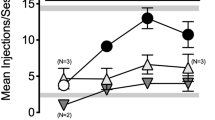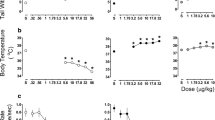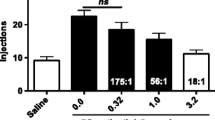Abstract
If different populations of opioid receptors mediate the actions of mu and kappa opioid agonists, then tolerance induced by the chronic administration of a mu agonist should confer cross-tolerance to other mu agonists but not necessarily to those compounds whose effects are mediated by the kappa receptor. This hypothesis was evaluated in the present investigation by examining the effects of the mu agonists morphine,l-methadone and fentanyl, the kappa agonists U50,488 and bremazocine, and the mixed kappa/mu agonist ethylketocyclazocine in rats responding under a fixed-ratio 30 schedule of food presentation before, during and after exposure to a regimen of chronic morphine administration. For comparison, naloxone was evaluated as a representative mu antagonist and the phenothiazine chlorpromazine as a control drug. During all phases of the experiment, each of these compounds produced dose-related decreases in rate of responding. During the daily administration of 40 mg/kg morphine, tolerance developed to the rate-decreasing effects of morphine,l-methadone and fentanyl, and an enhanced sensitivity to the effects of naloxone. In contrast to the effects obtained with these mu opioids, there was no evidence that chronic morphine administration produced tolerance or enhanced sensitivity to the rate-decreasing effects of U50,488, bremazocine, ethylketocyclazocine and chlorpromazine. The present findings demonstrate that the chronic administration of morphine results in the selective development of tolerance to other mu agonists. In addition, the lack of cross-tolerance between morphine and the kappa agonists examined demonstrate that this behavioral preparation is a useful tool for differentiating the effects of compounds acting at different opioid receptor types.
Similar content being viewed by others
References
Bergman J, Warren PH (1989) Effects of kappa opioids on schedule-controlled behavior of squirrel monkeys. J Pharmacol Exp Ther 248:1102–1108
Brady LS, Holtzman SG (1980) Schedule-controlled behavior in morphine-dependent and post-dependent rat. Psychopharmacology 70:11–18
Craft RM, Picker MJ, Dykstra LA (1989) Differential cross-tolerance to opioid agonists in morphine-tolerant pigeons responding under a schedule of food presentation. J Pharmacol Exp Ther 249:386–393
Doty P, Picker MJ, Dykstra LA (1989) Cross-tolerance to opioids in morphine-tolerant squirrel monkeys responding under a schedule of food presentation. Eur J Pharmacol 174:171–180
Dykstra LA (1983) Effects of ketocyclazocine and ethylketocyclazocine on electric shock titration. Eur J Pharmacol 94:19–26
Dykstra LA, Massie CA (1988) Antagonism of the analgesic effects of mu and kappa opioid agonists in the squirrel monkey. J Pharmacol Exp Ther 246:813–821
Dykstra LA, Gmerek DE, Winger G, Woods JH (1987) Kappa opioids in rhesus monkeys: I. Diuresis, sedation, analgesia and discriminative stimulus effects. J Pharmacol Exp Ther 242:413–420
Dykstra LA, Picker MJ, Powell KR (1990) Stereospecificity of mixed-action opioid agonists/antagonists in morphine-tolerant squirrel monkeys. Pharmacol Biochem Behav 36:639–644
Emmett-Oglesby MW, Shippenberg TS, Herz A (1988) Tolerance and cross-tolerance to the discriminative stimulus properties of fentanyl and morphine. J Pharmacol Exp Ther 245:17–23
France CP, Woods JH (1985) Effects of morphine, naltrexone, and dextrorphan in untreated and morphine-treated pigeons. Psychopharmacology 85:377–382
Gmerek DE, Dykstra LA, Woods JH (1987) Kappa opioids in rhesus monkeys III. Dependence associated with chronic administration. J Pharmacol Exp Ther 242:428–436
Harris RA (1980) Interactions between narcotic agonists, partial agonists and antagonists evaluated by schedule-controlled behavior. J Pharmacol Exp Ther 213:497–503
Hayes AG, Sheehan MJ, Tyers MB (1987) Differential sensitivity of models of antinociception in the rat, mouse and guinea-pig to μ- and κ-opioid receptor agonists. Br J Pharmacol 91:823–832
Heifetz SA, McMillan DE (1971) Development of behavioral tolerance to morphine and methadone using the schedule-controlled behavior of the pigeon. Psychopharmacologia 19:40–52
Holtzman SG (1985) Discriminative stimulus effects of morphine withdrawal in the dependent rat: suppression by opiate and nonopiate drugs. J Pharmacol Exp Ther 233:80–86
Howell LL, Bergman J, Morse WH (1988) Effects of levorphanol and several kappa-selective opioids on respiration and behavior in rhesus monkeys. J Pharmacol Exp Ther 245:364–372
Katz JL, Goldberg SR (1986) Effects of ethylketocyclazocine and morphine on schedule-controlled behavior in pigeons and squirrel monkeys. J Pharmacol Exp Ther 239:433–441
Lange DG, Roerig SC, Fujimoto JM (1980) Absence of cross-tolerance to heroin in morphine-tolerant mice. Science 208:72–74
Leander JD (1982) Effects of ketazocine, ethylketazocine and phenazocine on schedule-controlled behavior: antagonism by naloxone. Neuropharmacology 21:923–928
Leander JD (1983) A kappa opioid effect: increased urination in the rat. J Pharmacol Exp Ther 224:89–94
Magnan J, Paterson SJ, Tavani A, Kosterlitz HW (1982) The binding spectrum of narcotic analgesic drugs with different agonist and antagonist properties Naunyn-Schmiedeberg's Arch Pharmacol 319:197–205
McMillan DE, Mcgivney WT, Hardwick WC (1980) Effects of drugs on behavior in rats maintained on morphine, methadone or pentobarbital. J Pharmacol Exp Ther 215:9–14
Miller L, Shaw JS, Whiting EM (1986) The contribution of intrinsic activity to the action of opioids in vitro. Br J Pharmacol 87:595–601
Negus SS, Picker MJ, Dykstra LA (1989) Kappa antagonist properties of buprenorphine in non-tolerant and morphine-tolerant rats. Psychopharmacology 98:141–143
Picker MJ, Heise JW, Dykstra LA (1987) Evaluation of the effects of opioid agonists and antagonists under a fixed-consecutive-number schedule in rats. Pharmacol Biochem Behav 27:73–80
Picker MJ, Doty P, Negus SS, Mattox SR, Dykstra LA (1990a) Discriminative stimulus properties of U50,488 and morphine: effects of training dose on stimulus substitution patterns produced by mu and kappa opioid agonists. J Pharmacol Exp Ther 254:13–22
Picker MJ, Negus SS, Craft RM (1990b) Butorphanol's efficacy at mu and kappa opioid receptors: inferences based on its effects on the schedule-controlled behavior of non-tolerant and morphine-tolerant rats and on the responding of rats under a drug discrimination procedure. Pharmacol Biochem Behav 36:563–568
Porreca F, Cowan A, Raffa RB, Tallarida FJ (1982) Tolerance and cross-tolerance studies with morphine and ethylketocyclazocine. J Pharm Pharmacol 34:666–667
Raitano LA, McMillan DE (1983) Behavioral effects of the optical isomers of methadone in the rat during acute and chronic administration. J Pharmacol Exp Ther 226:440–448
Roerig SC, Fujimoto JM (1988) Morphine antinociception in different strains of mice: relationship of supraspinal-spinal multiplicative interaction to tolerance. J Pharmacol Exp Ther 247:603–608
Romer D, Buscher H, Hill RC, Maurer R, Petcher TH, Welle HBA, Bakel HCCK, Akkerman AM (1980) Bremazocine: a potent, long-acting opiate kappa agonist. Life Sci 27:971–980
Sannerud CA, Young AM (1986) Modification of morphine tolerance by behavioral variables. J Pharmacol Exp Ther 237:75–81
Schulz R, Wuster M (1981) Are there subtypes (isoreceptors) of multiple opioid receptors in the mouse vas deferens? Eur J Pharmacol 76:61–66
Schulz R, Wuster M, Herz A (1981) Differentiation of opiate receptors in the brain by the selective development of tolerance. Pharmacol Biochem Behav 14:75–79
Shannon HE, Holtzman SG (1976) Evaluation of the discriminative effects of morphine in the rat. J Pharmacol Exp Ther 198:54–65
Shearman GT, Herz A (1982) Evidence that the discriminative stimulus properties of fentanyl and ethylketocyclazocine are mediated by an interaction with different opiate receptors. J Pharmacol Exp Ther 221:735–739
Solomon RE, Goodrich JE, Katz JL (1988) Opioid receptor subtype-specific cross-tolerance to the effects of morphine on schedule-controlled behavior in mice. Psychopharmacology 96:218–222
Stevens CW, Yaksh TL (1989) Potency of infused spinal antinociceptive agents is inversely related to magnitude of tolerance under continuous infusion. J Pharmacol Exp Ther 250:1–8
Tallarida RJ, Murray RB (1987) Manual of pharmacologic calculations with computer programs. Springer, Berlin Heidelberg New York
Von Voigtlander PF, Lahti RA, Ludens JH (1983) U-50,488: a selective and structurally novel non-mu (kappa) opioid agonist. J Pharmacol Exp Ther 224:7–12
Young AM, Stephens KR, Hein DW, Woods JH (1984) Reinforcing and discriminative stimulus properties of mixed agonist-antagonist opioids. J Pharmacol Exp Ther 229:118–126
Author information
Authors and Affiliations
Rights and permissions
About this article
Cite this article
Picker, M.J., Negus, S.S. & Powell, K.R. Differential cross-tolerance to mu and kappa opioid agonists in morphine-tolerant rats responding under a schedule of food presentation. Psychopharmacology 103, 129–135 (1991). https://doi.org/10.1007/BF02244087
Received:
Revised:
Issue Date:
DOI: https://doi.org/10.1007/BF02244087




